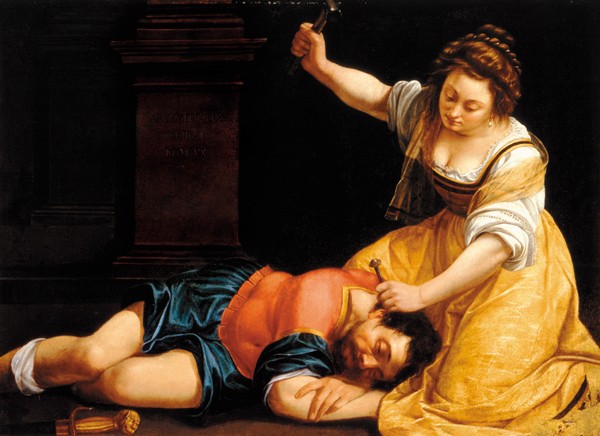Deborah, the only female judge in the Bible, excelled in multiple areas.1 Clearly one of the Bible’s most outstanding figures, she served ancient Israel as a prophet,2 judge, military leader, songwriter, and minstrel (Judges 4–5).

The only woman who judges, Deborah “used to sit under the palm tree…and the sons of Israel came up to her for judgment” (Judges 4:5). She is shown here in a stained glass window by the Russian-Jewish artist Marc Chagall. Photo: © 1997 Artists Rights Society (ARS), NY/ADAGP, Paris.
The two chapters show her exemplary moral character and indicate the people gave her great love and respect. Like Moses before3 and David afterward, she fused in herself the roles of prophet, national leader, and military commander.
Thought to be an Ephramite because she resided in Ephraim (4:5), Deborah judged and led Israel for 60 years in the 12th century B.C.4 Her oversight covered approximately 20 years of national hardship before the Canaanite war and then a peaceful aftermath of 40 years. Arguably, Deborah first was recognized as a prophet, then as judge/leader, next in a military role (5:15), and finally as a songstress. She judged under a palm tree—a setting, rabbinic tradition maintains, that validated her fairness, openness, and refusal to show partiality.5
Deborah is introduced, as are the other 11 judges in the Book of Judges, without fanfare. The Bible records no dissent or rebellion against her. Leadership resides not in gender but in character and gifting.6 The Israelites recognized her abilities and prospered under her tenure. Her name means bee or even honeybee.
Judges 4–5 is unusual in that it chronicles a slice of biblical history first in narration and subsequently in poetry. The chapters complement each other, fitting together details, insights, and judgments.
The two chapters begin with Israel’s disobedience, vividly describe a Holy War and its participants, and end with the victorious result: the land had rest for 40 years (5:31). Put another way, the people sinned, learned from hardship, repented, and cried out to the Lord. The Lord responded with a plan of deliverance.
Although the Canaanites didn’t know it, this was a Holy War.7

The chapters present the possibility of three war zones: the initial battleground of Mount Tabor and the Jezreel Valley (4:12); Tanaach (5:19); and the gates of Hazor and other Canaanite cities. (4:23; 5:11d).
Chapters 4 and 5 provide character sketches of those involved in the war. The men include:
- Barak, who, at Deborah’s command, suddenly becomes Israel’s general; he bargains with Deborah to come with him to the war; she agrees but prophesies that “the Lord will sell Sisera into the hand of a woman” (4:8–9)
- Jabin, a king in Canaan who resides in Hazor (4:2)
- Sisera, Jabin’s general, who exudes confidence because of his weapons of mass destruction—some 900 iron chariots (4:2–3)
- The tribes of Naphtali and Zebulon followed by Ephraim, Benjamin, and Issachar and the men of Machir; all march with Barak and are praised by Deborah (5:14–15)
- The tribes of Reuben, Dan, and Asher and the men of Gilead (5:15–17); they are ridiculed for failing to heed the summons to the Holy War
In addition to Deborah, the women include:
- Jael the Kenite, who invites the fleeing Sisera into her tent and murders him (4:17–22; 5:24–27)
- Sisera’s mother, who, Deborah imagines, waits anxiously at a latticed window for her son’s return (5:28)
- Nearby ladies-in-waiting who speculate that the victorious Canaanites are delayed because they’re busy dividing the spoils of war and enjoying the women they’ve conquered (5:29–30)
Those mentioned only incidentally include:
- Lappidoth, the husband of Deborah (4:4)8
- Heber the Kenite, husband of Jael (4:11); according to tradition, the Kenites descended from Jethro, Moses’ father-in-law9
Deborah’s tenure starts with the Lord’s judgment against Israel. Because the Israelites did evil in the eyes of the Lord, the Lord sells them into the hand of Jabin, a king in Canaan (4:1–2). Confined to the unproductive hilltops and denied commercial access on the highways, the Israelites suffer economic hardship under the Canaanites (5:6).
Deborah summons Barak from Kadesh in Naphtali; she tells him the Lord commands him to position himself at Mount Tabor and bring in 10,000 from the tribes of Naphtali and Zebulon (4:5–6). The Lord shares his strategy and promises deliverance and victory: “I will draw out Sisera, the general of Jabin’s army, to meet you by the Wadi Kishon with his chariots and his troops; and I will give him into your hand” (4:6–7).
Chapter 4 highlights the conflict between the Israelites and Canaanites. Tribes assemble under Barak’s order. Sisera hears and takes his chariots to the Wadi Kishon (4:12–13). Making good his word, the Lord throws Sisera and his forces into panic (4:15). Seeing that the battle goes against the Canaanites, Sisera flees on foot. Exhausted, he arrives at Jael’s tent. She brings him milk, covers him with a rug, and while he sleeps, hammers a tent peg through his head (4:17–21)! The assassination incorporates multiple erotic images.10 Barak, coming shortly thereafter, views the corpse (4:22).

As Sisera sleeps, Jael calmly and quietly hammers a tent peg into his temple, in this 1620 painting by Italian Renaissance artist Artemisia Gentileschi. Photo: Szepmuveszeti Museum, Budapest, Hungary.
The poetry in Chapter 5, the Song of Deborah, smacks of realism and emphasizes the role of women.11 The ballad tells a gripping story, ringing with eyewitness details. Like the Book of Lamentations and the Gospel of Mark, it leaves a reader feeling breathless. One easily imagines Deborah strumming and beckoning Barak to walk and sing with her among their victorious countrymen. Her leadership style favors a team approach; she willingly recognizes those who joined and served.12 She not only praises others but also thereby encourages them to ongoing service and development as leaders.13
Considered one of the oldest pieces of Hebrew poetry,14 Deborah’s Song continues the Israelite tradition of immortalizing a victory in song. Both Moses and Miriam led the Israelites in songs of victory after the crossing of the Sea of Reeds (Exodus 15:1–21). Deborah’s song has many Hebrew words that are unknown now; that’s why its translations vary so much.
Deborah sings about the Lord but to the Israelites. For example, the earth trembled, the clouds poured water, the Lord marched, and the mountains quaked “before the Lord” (5:4–5). Indeed, the stars in heaven fought against the doomed Sisera and the Canaanites (5:20). Credit for the Holy War and inevitable victory goes to Yahweh (5:5).
Become a Member of Biblical Archaeology Society Now and Get More Than Half Off the Regular Price of the All-Access Pass!
Explore the world’s most intriguing Biblical scholarship
Dig into more than 9,000 articles in the Biblical Archaeology Society’s vast library plus much more with an All-Access pass.

Deborah calls herself a mother in Israel (5:7). Probably one of the highest designations in scripture, it indicates authority.15 Centuries afterward, the wise woman of Abel Beth Maacah will describe her city with the same phrase in a conversation with military leader Joab during a break in a civil war (2 Samuel 20:19). Much earlier, Joseph called himself a father to Pharaoh (Genesis 45:8).
Deborah’s concluding words validate Jael’s action, pronouncing her “most blessed of women” Judges 5:24). Similar designations go to Mary, the mother of Jesus (Luke 2:26–28, 42), and to Judith, heroine of the Apocryphal Book of Judith who beheaded Holofernes, an Assyrian, general and saved her people (Judith 13:23–25). With great force, Deborah prays that all the Lord’s enemies will share Sisera’s fate and likewise perish (Judges 5:31).
Deborah’s War changed history. Any dreams Sisera had to use those 900 chariots to defeat Egypt and become a world power literally got stuck in the mud when the Lord sent rain (5:4, 21). Deborah’s War effectively took the Canaanites off the world stage. Yes, the Israelites moved to the fertile valleys and vended their wares on recognized thoroughfares (5:7). But perhaps a misstep was that the Israelites did not become masters of the forge; they did not capture, copy, or customize the enemy’s technology. Consequently, nearby nations excelled in iron smelting. The judge Gideon built on Deborah’s military foundation and led Zebulon, Naphtali, and other tribes against the Midianites and Amalekites (6:33-35). According to rabbinic tradition, Deborah wrote Psalm 6816; it clearly resembles both chapters, especially Judges 5.17
According to another rabbinic tradition, descendants of Sisera, the Canaanite commander whose doom was prophesied by Deborah and fulfilled under Jael’s hand, taught children in Jerusalem.18 If that tradition is true, then it shows one of the great themes of scripture. The judgeship of Deborah started with the Israelites’ sin but its legacy, in time, included God’s good work of redemption in the lives of the descendants of Israel’s enemy.
This Bible History Daily feature was first published in April, 2019
 Robin Gallaher Branch teaches Old Testament and New Testament as an adjunct professor at Christian Brothers University in Memphis, Tennessee. She was awarded a Fulbright Fellowship for the 2002–2003 academic year and served in the Faculty of Theology at North-West University in Potchefstroom, South Africa; she retains her North-West research affiliation. She received her Ph.D. in Hebrew Studies from the University of Texas in Austin in 2000. Her most recent books are Six Biblical Plays for Contemporary Audiences (Cascade 2016) and Jeroboam’s Wife: The Enduring Contributions of the Old Testament’s Least-Known Women (Hendrickson, 2009; Wipf and Stock, 2018).
Robin Gallaher Branch teaches Old Testament and New Testament as an adjunct professor at Christian Brothers University in Memphis, Tennessee. She was awarded a Fulbright Fellowship for the 2002–2003 academic year and served in the Faculty of Theology at North-West University in Potchefstroom, South Africa; she retains her North-West research affiliation. She received her Ph.D. in Hebrew Studies from the University of Texas in Austin in 2000. Her most recent books are Six Biblical Plays for Contemporary Audiences (Cascade 2016) and Jeroboam’s Wife: The Enduring Contributions of the Old Testament’s Least-Known Women (Hendrickson, 2009; Wipf and Stock, 2018).
Notes:
1. Branch 2002, p. 134.
2. Rabbinic tradition lists seven prophetesses: Sarah, Miriam, Deborah, Hannah, Abigail, Huldah, and Esther (Meg. 14a) (“Deborah,” p. 489).
3. Herzberg 2013, pp. 15–16. Herzberg notes the prophetic gifting of both Moses and Deborah and the similarities of the crossing of the Sea of Reeds and Deborah’s War; consequently he argues Deborah was seen as “the Moses of her time” (2015, p. 33).
4. Zucker and Reiss 2015, p. 32.
5. “Deborah,” p. 490.
6.Nielson 2018, pp. 78–79. Both men and women are made in the image of God.
7. Boda (2012, p. 1137) notes that Israel’s success and the Canaanites’ failure are directly related to their relationship to Yahweh.
8. “Wife of Lappidoth” also could be translated “woman of torches” or “woman of flame”; rabbinic tradition notes that Deborah was “a great light in Israel” (“Deborah,” p. 489).
9. “Sisera,” p. 397.
10. Ackerman 1998, pp. 59–61.
11. Haddox 2013, p. 79.
12. Kroll 2006, pp. 34–35.
13. Nielson 2018, p. 85.
14. Branch 2002, p. 134.
15. Meyers 2000, p. 332.
16. Branch 2002, p. 135.
17. Wright 2011, pp. 529–531.
18. “Sisera,” p. 398. Git 57b.
Bibliography:
Susan Ackerman, Warrior, Dancer, Seductress, Queen: Women in Judges and Biblical Israel. The Anchor Bible Reference Library (New York: Doubleday, 1998).
Mark J. Boda, “Judges,” in Tremper Longman III and David E. Garland, eds., The Expositor’s Bible Commentary. Revised Edition. Volume 2 (Grand Rapids, MI: Zondervan, 2012), pp. 1043–1288.
Robin Gallaher Branch, “Deborah,” in Catherine Clark Kroeger and Mary J. Evans, eds., The IVP Women’s Bible Commentary (Downers Grove, IL: InterVarsity Press, 2002), pp. 134–135.
“Deborah,” The Jewish Encyclopedia. Volume IV (New York: KTAV Publishing House) pp. 489–490.
Susan Haddox, “Gendering Violence and Violating Gender in Judges 4–5,” Conversations with the Biblical World 33, pp. 67–81 (2013).
Bruce Herzberg, “Deborah and Moses,” Journal for the Study of the Old Testament 38, pp. 15–33 (2013).
Woodrow Kroll, Judges: Ordinary People, Extraordinary God (Wheaton, IL: Crossway Books, 2006).
Carol Meyers, “Deborah,” in D. N. Freedman, ed., Eerdmans Dictionary of the Bible (Grand Rapids, MI: William B. Eerdmans Publishing Company, 2000), pp. 331–332.
Kathleen Nielson, Women & God: Hard Questions. Beautiful Truth (Good Book Company, 2018).
“Sisera,” The Jewish Encyclopedia. Volume XI (New York: KTAV Publishing House), pp. 397–398.
Jacob L. Wright, “Deborah’s War Memorial: The Composition of Judges 4–5 and the Politics of War Commemoration,” Zeitschrift fur die alttestantliche Wissenschaft 123, pp. 516–534 (2011).
David Zucker, and Moshe Reiss, “Subverting Sexuality: Manly Women; Womanly Men in Judges 4–5,” Biblical Theology Bulletin 45, pp. 32–37 (2015).
The post Deborah in the Bible appeared first on Biblical Archaeology Society.

0 Commentaires